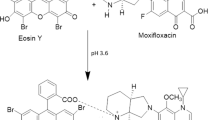Abstract
The interaction between Norfloxacin (NF) and Proflavine hemisulphate (PF) was investigated by spectroscopic tools like UV–VIS absorption and Fluorescence spectroscopy. It was proved that fluorescence quenching of NF by PF is due to the formation of NF-PF complex which was supported by UV–VIS absorption study. The study of thermodynamic parameters suggested that the key interacting forces are hydrogen bond and van der Waal’s interactions and the binding interaction was spontaneous. The distance r between NF and PF was obtained according to the Förster’s theory of non-radiative energy transfer. The fluorescence quenching mechanism was applied to estimate PF directly from pharmaceutical samples.











Similar content being viewed by others
References
Mitchel GAG, Buttle GAH (1943) Proflavine in closed wounds. Lancet 242:749
Nash SC, Ketcham AS, Smith RR (1962) Effect of local irrigation with Proflavine Hemisulfate on wounds seeded with tumor cells an experimental study. Ann Surg 155(3):465–471
Hunt PB, Ford JL (1983) Release of Proflavine hemisulphate from proflavine preparations currently in use within the mersey regional health authority. J Clin Hosp Pharm 8(4):345–348
Nelson JM, Chiller TM, Powers JH, Angulo FJ (2007) Food safety: fluoroquinolone-resistant campylobacter species and the withdrawal of fluoroquinolones from use in poultry: a public health success story. Clin Infect Dis 44(7):977–980
Rafalsky VV, Andreeva IV, Rjabkova EL (2006) Quinolones for uncomplicated acute cystitis in women. Cochrane Database Syst Rev 3:CD003597
Drlica K, Zhao X (1997) DNA gyrase, topoisomerase IV and the 4-quinolones. Microbiol Mol Biol Rev 61(3):377–392
More VR, Mote US, Patil SR, Kolekar GB (2010) Fluorescence quenching studies on the interaction between Riboflavin and Norfloxacin and Analytical application on determination of vitamin B2. J Solution Chem 39(1):97–106
Son GS, Yeo JA, Kim MS, Kim SK, Holmén A, Akerman B, Norden B (1998) Binding mode of Norfloxacin to calf thymus DNA. J Am Chem Soc 120(26):6451–6457
Song G, He Y, Cai Z (2004) A fluorescence spectroscopic study of the interaction between Norfloxacin and DNA. Can J Anal Sci Spectrosc 49(4):203–209
More VR, Mote US, Patil SR, Kolekar GB (2009) Spectroscopic studies on the interaction between Norfloxacin and p-Amino benzoic acid: analytical application on determination of Norfloxacin. Spectrochim Acta A 74(3):771–775
Park HR, Seo JJ, Shin SC, Lee HS, Bark KM (2007) Fluorescence quenching of Norfloxacin by divalent transition metal cations. Bull Korean Chem Soc 28(9):1573–1578
Ackermann NB, Haldorson DK, Tendik FH, Elslager EF (1968) Preparation and screening of aminoacridines for induction of lung tumor fluorescence in rats. J Med Chem 11(2):315–321
Faller LD, LaFond RE (1971) Binding properties of oligomeric α-chymotrypsin. Biochemistry 10(6):1033–1041
Fernandez-Arguelles MT, Canabate B, Costa-Fernandez JM, Pereiro R, Sanz-Medel A (2004) Flow injection determination of nitrite by fluorescence quenching. Talanta 62(5):991–995
Lee WE, Galley WC (1988) Perturbations to the intersystem crossing of proflavin upon binding to DNA and poly d(A-IU) from triplet-delayed emission spectroscopy. J Biophys 54(4):627–635
Thomes JC, Weill G, Daune M (1969) Fluorescence of Proflavine–DNA complexes: heterogeneity of binding sites. Biopolymers 8(5):647–659
Chakraborty B, Basu S (2009) Interaction of BSA with Proflavin: a spectroscopic approach. J Lumin 129(1):34–39
Girousi ST, Alexiadou DK, Ioannou AK (2008) An electroanalytical study of the drug Proflavine. Microchim Acta 160(4):435–439
Alexiadou DK, Ioannou AK, Kouidou-Andreou S, Voulgaropoulos AN, Girousi ST (2008) Electrochemical study of the interaction mechanism of Proflavine (PF) with DNA using Carbon Paste (CPE) and Hanging Mercury Drop (HMDE) Electrode. Anal Lett 41(10):1742–1750
Shaw WHC, Wilkinson G (1952) The colorimetric estimation of small quantities of Proflavine hemisulphate. Analyst 77(912):127–132
Evstigneev MP, Mukhina YV, Davies DB (2006) 1H NMR study of the hetero-association of flavin-mononucleotide with mutagenic dyes: ethidium bromide and proflavine. Mol Phys 104(4):647–654
Lakowicz JR (2006) Principles of fluorescence spectroscopy, 3rd edn. Plenum Press, New York
Mote US, Bhattar SL, Patil SR, Kolekar GB (2010) Interaction between felodipine and bovine serum albumin: fluorescence quenching study. Luminescence 25(1):1–8
Bhattar SL, Kolekar GB, Patil SR (2008) Fluorescence resonance energy transfer between perylene and riboflavin in micellar solution and analytical application on determination of vitamin B2. J Lumin 128(3):306–310
Mote US, Bhattar SL, Patil SR, Kolekar GB (2009) Interaction of fluorescein with felodipine: a spectrofluorometric and thermodynamic study. J Solution Chem 38(5):619–628
Ross PD, Subramanian S (1981) Thermodynamics of protein association reactions: forces contributing to stability. Biochemistry 20(11):3096–3102
Bhattar SL, Kolekar GB, Patil SR (2010) Spectroscopic studies on the molecular interaction between salicylic acid and riboflavin (B2) in micellar solution. J Lumin 130(3):355–359
Mote US, Han S-H, Patil SR, Kolekar GB (2010) Effect of temperature and pH on interaction between bovine serum albumin and cetylpyridinium bromide: fluorescence spectroscopic approach. J Lumin 130(11):2059–2064
Acknowledgment
One of the authors (VRM) express his gratitude to the Department of Chemistry, The New College, Kolhapur for their kind encouragement.
Author information
Authors and Affiliations
Corresponding author
Rights and permissions
About this article
Cite this article
More, V.R., Anbhule, P.V., Lee, S.H. et al. Fluorimetric Study on the Interaction between Norfloxacin and Proflavine Hemisulphate. J Fluoresc 21, 1789–1796 (2011). https://doi.org/10.1007/s10895-011-0873-8
Received:
Accepted:
Published:
Issue Date:
DOI: https://doi.org/10.1007/s10895-011-0873-8



